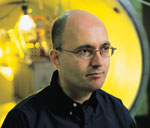Making Waves
Pulsed power lab earns worldwide recognition
Imagine devices that harness high power pulses of energy to treat cancer, extract oil from wells or even disable an enemy's communications systems. A team of researchers at UNM's Department of Electrical and Computer Engineering (ECE) not only imagines these devices - they are helping create them.
 Edl Schamiloglu, laboratory director and Gardner-Zemke Professor in the ECE department, leads an interdisciplinary team of scientists and researchers studying pulsed power-driven high power microwave sources. Through their research, the team is helping develop new devices that use high-power microwaves for a variety of purposes.
Edl Schamiloglu, laboratory director and Gardner-Zemke Professor in the ECE department, leads an interdisciplinary team of scientists and researchers studying pulsed power-driven high power microwave sources. Through their research, the team is helping develop new devices that use high-power microwaves for a variety of purposes.
The UNM team has worked diligently on their research for 15 years and is now receiving worldwide attention for their efforts. Day in and day out we ve been doing our jobs, pursuing our line of research and staying close to our skill set and our expertise. And it just so happens that we re now seeing the net results of all this work, says Schamiloglu.
Pulsed power technology - and Schamiloglu - have received extensive media attention in the past year because researchers in the U.S. Department of Defense are developing weapons that use high power microwaves to disable computer and communications systems. According to media speculation, some of those non-lethal devices may have been used in Iraq.
Pulsed Power At Work
While the defense systems have received a lot of attention, Schamiloglu is quick to point out pulsed power s versatility. "The technology behind what we re working on has many different applications that are non-defense oriented. I think, increasingly, a lot of these applications will find their way into our daily lives.
For instance, Schamiloglu collaborated with a doctor and physicist at UNM's Cancer Research and Treatment Center to use pulsed power to help treat patients with brain tumors. Doctors were using a linear accelerator to image and treat tumors. The machine was effective at "zapping" tumors, but its extremely high energy levels created blurry pictures for verification before treatment. Schamiloglu suggested mounting a pulsed power device on top of the linear accelerator, like the scope on a rifle. The pulsed power device created crisp images that were more useful for lining up the linear accelerator. After reviewing the new, clear images, doctors used the linear accelerator for treatment without moving the hardware or the patient. Schamiloglu, who along with his colleagues patented the solution, says that while not in regular use today, the technology may find its way into clinical settings in the future.
A world away from UNM, deep in the Russian oil fields, pulsed power's potential is literally earthshaking. There, oil companies lower pulsed power-driven shock generators into dormant wells to shake extra oil from the ground. The process, which is akin to tapping the bottom of an almost-empty ketchup bottle, creates localized shock waves within the wells, and draws out oil that cannot be extracted cost-effectively by using conventional drilling methods.
Pulsed power technology is also used in materials science applications where high-energy beams create metals with smoother surfaces, harden machine tools for longer life and prepare material surfaces for bonding to different agents. Other pulsed power applications include purifying municipal water systems and deactivating potential biological contaminants. With the nation's interest focused on homeland security, these applications have received renewed attention.
Indeed, the possibilities for using pulsed power in a variety of applications are top-of-mind for companies and scientists around the world. National and international organizations, as well as scientists from Japan, Israel, Germany, Singapore and other countries have contacted Schamiloglu and his team about their research.
The team at UNM is now looking to the future of the technology. “This research is putting UNM in the top two or three universities that have the capability to study the future effect of this technology. We're now in a position to turn the tables and use our research to help protect buildings in the civilian infrastructure - like hospitals and airports - that house sensitive electrical equipment," says Christos Christosdoulou, professor and chair of the ECE Department.
A Directed Energy Powerhouse
UNM is one of a handful of universities that has both a research and education program in pulsed power. Schamiloglu says that collaboration between other university laboratories in the U.S. and around the world that conduct pulsed power research has been critical to his team's success. "The nature of the problems that we're addressing is so complex that no one institution has all the resources and skill sets to be able to make an impact. That's why it's always good to leverage complementary skills with another university."
However, most pulsed power research is centralized in New Mexico because both Sandia National Laboratories and Los Alamos National Laboratory have ongoing programs in high energy density plasma physics research, including high power microwave generation. SaysSchamiloglu, "The largest amount of pulsed power research in the UnitedStates goes on in New Mexico. It's important to our state. So it only makes sense that UNM maintain a very strong program in this area. It’s something we're good at. And it's an opportunity to be among the best in the country and among the best in the world."
